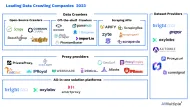Top 5 Data Collection Use Cases/Purposes in 2024
Data collection has become a core operation in almost every successful business. Organizations want to generate and use more data to elevate their businesses and fuel their digital transformation initiatives.
However, all that glitter is not gold since many companies still do not know how to use data effectively.
This article is curated to remedy this issue by highlighting the top 5 data collection uses/reasons/purposes to help clarify why data collection is done and where that data can be used.
Disclaimer: The list of use cases provided in this article is not exhaustive. There might be other uses of data collection that are not mentioned here. This list only highlights the key use cases identified through research.
1. Train AI/ML models
One of the most common uses of data collection or harvesting is to train AI-powered solutions such as computer vision (CV), facial recognition, etc. Gathering data to prepare a training dataset is a prerequisite to training AI/ML solutions. The process of data collection is done based on the model’s learning modality (multimodal or unimodal). In the case of multimodal learning, multiple types of data are collected (image, audio, video, etc.); for unimodal training, only a single type of data is gathered.
Studies show that the size of the training dataset is positively correlated with the accuracy of the model (see Figure 1). The quality assurance of the data is another factor that’s important while training an AI/ML model.
However, data collection can be challenging and expensive, especially if done in-house, at a large scale, and in high quality. Companies can outsource their data collection or work with crowdsourcing data collection service providers to overcome such challenges.
Watch their video to learn more:
Figure 1. Accuracy increases as dataset size increases, regardless of the type of model being trained.
2. Deploy AI/ML models
Another purpose of data collection is to deploy AI/ML models. While 60% of the data from a dataset goes towards training and 20% goes towards validation, the rest goes towards testing the dataset for deployment.
At the deployment stage, fresh data is required to check if the model has become under or overfitted to the training dataset or is performing optimally to the new dataset.
The testing dataset ensures that the model is ready to be deployed in the real world.
3. Improve AI/ML models
Once a machine learning model is deployed, it should keep on getting improved. . After being deployed, the performance or accuracy of an AI/ML model degrades over time (See Figure 2). This is mainly because data, and the circumstances in which the model is being used, change over time.
For instance, a quality assurance system implemented on a conveyor belt will perform sub-optimally if the product that it is analyzing for defects changes (i.e., from apples to oranges). Similarly, if a model works on a specific population, and the population changes over time, that will also impact the performance of the model.
Figure 2: Performance of a model decaying overtime
In the aforementioned situation, the model needs fresh data to be re-trained to restore or improve the performance levels. This is where data collection services can be leveraged to provide new datasets that can re-train machine learning models (see Figure 3).
Figure 3. A regularly retrained model with new data
4. Online Marketing
Another purpose of data collection is to improve online marketing. Data can be used in the following ways in online marketing:
4.1. Conducting an online search
Data collection is a fundamental part of any type of research, especially when primary data collection is required. Whether it is to develop a new product or improve a service, data is integral to conducting research.
For instance, online surveys can be conducted to learn about the user-friendliness of a product. Conducting such surveys requires recruiting a large group of people who have used that particular product.
This type of data can be gathered in-house if the company has the budget and manpower to spare. Otherwise, it can be outsourced or crowdsourced to third-party service providers who can do it for you for a price.
4.2. Learn customers’ sentiment
Sentiment analysis helps the company understand the attitude of customers towards their brand via their feedback.
For instance, sentiment analysis can be conducted on social media to collect sentiment data from different platforms such as Facebook, Twitter, etc. This can help the business learn what keywords customers are using to describe their brand.
5. Search Engine Optimization
Data collection can also be used to perform search engine optimization for online businesses. Creating product descriptions, for example, can benefit from data collection services.
For instance, if a company needs to launch its online business in China, it will require data in Mandarin to be added to the website’s product description section for each product. This is because up-to-date and accurate data in product descriptions are good for SEO and, ultimately, for business.
However, this can be significantly challenging if done in another language and for thousands of products. Depending on the scale of the business, collecting product description data can also be outsourced or crowdsourced by working with specialist third-party firms.
You can also check our data-driven list of top data collection/harvesting companies to find the best one for your projects.
For more in-depth knowledge on data collection/harvesting, feel free to download our whitepaper:
Further reading
- Top 4 Data Collection Methods
- Top 6 Data Collection Best Practices
- Ethical & Legal Data Collection for AI Training with Case Studies
If you need help finding a vendor, or have any questions, feel free to contact us:



Comments
Your email address will not be published. All fields are required.